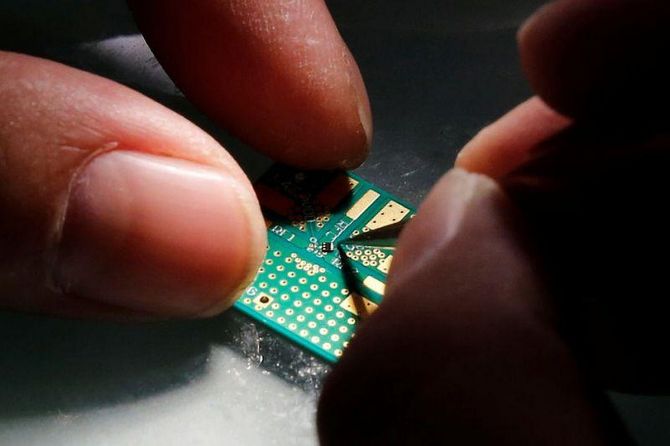The exclusive club that dominates the global semiconductor fab scenario is about to get a new member.

Taiwan, South Korea, and China control nearly 70 per cent of the global capacity.
SEMI, the global industry body for semiconductor and electronics design and manufacturing, projects all fabs collectively will churn out 30 million wafers a month this year.
Soon there will be a new entrant into this cosey club.
After 17 years of toil, India is finally ready for its tryst with semiconductors.
On Thursday, the Union Cabinet approved Rs 1.26 trillion worth of investments in three semiconductor plants, including one by the Tata group to build India’s first major chip fabrication facility at Dholera in Gujarat.
The Cabinet also cleared a separate Tata proposal for a chip assembly and testing plant in Morigaon, Assam, and another by CG Power in Sanand, also in Gujarat.
Work on all three is expected to begin within 100 days.
The Tata group’s Dholera plant entails an investment of Rs 91,000 crore and will churn out 28-nanometre and above chips — known for high performance and low power consumption — beginning with 50,000 wafter starts per month.
It has tied up with the third- largest Taiwanese chip maker, PSMC, for the crucial technology.
PSMC might take equity.
Tata’s Assam project, for which Rs 27,000 crore is earmarked, will do semiconductor assembly, testing, marking, and packaging (ATMP). Deploying indigenous technology, it will process the wafers manufactured in Dholera, as well as wafers made by other companies, into “make in India” chips.
Twists and turns
The journey did not start on a good note. In 2007, Intel, which wanted to set up a fab plant in India, blamed lack of clarity in government policy and moved its wares to China.
Subsequent attempts did not work out either.
Things began to move in earnest in 2022, when Prime Minister Narendra Modi launched a Rs 75,000 crore semiconductor incentive scheme to woo global and Indian players.
In an interview last week with Business Standard, Ashwani Vaishnaw, the communications, electronics & IT minister, elaborated on the government’s vision.
“We have a 20-year vision for semiconductors.
"In the next five years, we would like to see four to six more fabs, six to 10 semiconductors, one or two display fabs, and eight to 10 ATMP plants.
"This will go a long way in creating atmanirbharata in semicon,” he said.
Vaishnaw sees India playing an important role in the semiconductor sweepstakes.

In five years, India is looking at grabbing 10 per cent of the ATMP, or outsourced semiconductor assembly and test (OSAT) market, rising to more than 25 per cent in 10 years.
He acknowledges the strategic importance of Indian fabs being set up in other countries as well.
That is ambitious, to say the least.
Long road ahead
Forget about Taiwan and China, which together have 70 per cent share of the OSAT-ATMP market.
Even Malaysia is a force, with a 14 per cent share already in its bag.
So, there is a huge catch-up for India to do.
This catch-up cannot happen in a hurry.
Tata’s fab capacity will take two to three years to start rolling and have a minor share of the global capacity. To complicate matters, it will come at a time when it would be raining fabs, as countries justle to set up mega plants to safeguard against the kind of supply chain disruption seen after Covid.
The US, for instance, is going on an overdrive to regain its chip-making glory.
It has only an 8 per cent share of the global fab capacity, while China’s has grown to 22 per cent.
After the slowdown of 2023, says SEMI, 82 fab plants, including new ones and capacity expansion, will be operational during 2022-24 — the majority in 28 nanometres.
In 2024 alone, 42 fab plants will join the fray, raising concerns about a possible oversupply.
Companies including TSMC, Intel, Micron, and Samsung are investing over $500 billion by the year-end in building fabs in their home countries as well as in the US and Europe, where the supply chain is established, instead of looking at newer countries.
India’s investment in fab and ATMP together would account for a mere 3.6 per cent of what the big guns are investing.
The country’s subsidy incentive scheme is only 18 per cent of what the US offers ($52 billion).
Also, the US and China are locking horns. About 40 per cent of the new plants are being built in the US, of which six will be operational in 2024.
But China is moving faster, with 18 new plants slated to go on stream this year.
Malaysia and Singapore, too, have built a vibrant fab business, already accounting for 4 per cent of the global capacity.
Vietnam, which has a vibrant OSAT segment, will compete with India in wooing investments.
Silver linings
That said, India’s attractiveness is growing.
The domestic demand for semiconductors across industry segments is too big to ignore.
Tata says India’s demand will cross $110 billion by 2030.
That would be 11 per cent of the demand.
Of course, China will by that time touch $180.5 billion.
Despite the constraints of a new player, India has begun well.
PSMC, the 10th-largest fab company by revenues, was looking overseas and, according to its chairman Frank Huang, had offers from eight nations to set up a fab plant.
But it chose India, where it will provide technology and also take equity in the Tata project.
Japanese microcontroller maker Renesas, which has tied up with CG Power, a Murugappa group firm, to set up an ATMP-OSAT plant in India, will bring in specialised chip technology to be processed in the country.
In the same space, Micron has decided to set up an ATMP plant in India, which will process imported wafers into chips and export them back.
Its plant would be one of the largest and do a value-addition of 10-40 per cent.
It also plans to rope in its key vendors to set up shop and eventually sell chips directly to clients in India, one of which is Apple.
If the project works out, government officials say, Micron is open to a fab plant in India.
Vaishnaw says subsidies will have to continue till India has enough semiconductor infra in place.
But the Rs 75,000 crore earmarked as incentives under the semicon scheme has been exhausted by the new projects.
Tower Corporation, for instance, has applied for an $8 billion fab plant and two other OSAT-ATMP applications are awaiting clearance.
Industry estimates that these three could require another $4-5 billion in incentives.
The good news, indicates Vaishnaw, is that money would not be an issue for such a strategic sector.










